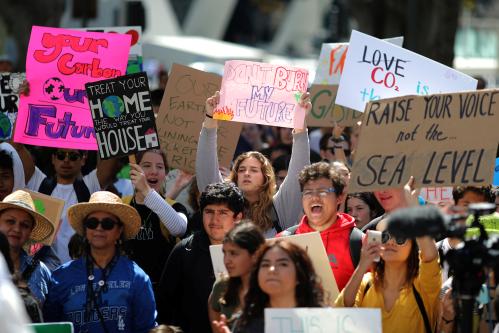As the COVID-19 pandemic upended long-settled fossil fuel supply and demand expectations, natural resource governance experts contemplated something that seemed politically insurmountable just a year ago: a sharp restructuring of fuel subsidy systems across the world.
Initially, the pandemic-fueled events of 2020—which included a dramatic drop in oil prices and consumption as part of a general global economic downturn—was seen as an unexpected entry point for much-needed fuel subsidy reform efforts as some countries cut fuel subsidies. But whether these cuts presage durable reform or were simply short-term situational responses remains an open question.
Fuel subsidies are rampant across the world. From Iran to Argentina to Nigeria, governments subsidized fossil fuels and electricity to the tune of at least $320 billion in 2019—while using a broader definition of subsidies that includes associated externalities of pollution, climate change, and more—raises the true price tag to around $5 trillion (in 2015).
Prior to the pandemic, the world’s largest direct benefit transfer was a fuel subsidy program in India that at one point helped more than half of the country’s population access low-cost liquified petroleum gas for use in cooking. India is not unique: A 2019 OECD inventory of fuel subsidies administered across 44 countries (including subnational jurisdictions) chronicled more than 1,000 of them. In total, fuel subsidies are in place in more than 40 countries, with the largest amount going to oil, followed by electricity.
There are a number of ways to define a fuel subsidy. In general, we follow the one used by World Bank researchers: “a deliberate policy action by government that specifically targets oil, gas, coal, or fossil-fuel-based electricity or heat, with one or more of the following effects: 1. Reducing net cost of energy purchased; 2. Reducing cost of production or delivery of energy; 3. Increasing revenues retained by energy suppliers.”
Many governance, development, environment, and finance organizations have advocated for a restructure of the global fuel subsidy system. Fuel subsidies have significant cross-cutting effects on the climate, poverty, and governance that cannot be ignored. In addition, fuel subsidy systems can serve as corruption hubs, distort a nation’s macroeconomic fortunes, or misallocate scarce social welfare assets.
These concerns about fuel subsidies are compelling. First, countries that are economically dependent on extraction of oil, gas, and coal face an urgent need to diversify their economies—not least because responses to the climate crisis will drive cuts in fossil fuel use while renewables become increasingly competitive. For resource-rich countries dependent on oil, gas, or coal revenues, subsidies in effect double-down on commodities with an uncertain economic future.
Fuel subsidy reform, then, is seen not only as a macroeconomic necessity, but also as a valuable tool for tackling the climate crisis. Indeed, one study found that eliminating fossil fuel subsidies alone would reduce global greenhouse emissions between a 1% to 10% reduction by 2030 and between a 6.4% and 8.2% by 2050. (To be sure, that level of emission reduction is not sufficient for countries to meet their Paris Agreement obligations, but eliminating fuel subsidies is nonetheless a powerful tool in the arsenal.)
Second, even without the environmental benefits, the socioeconomic case for slashing fuel subsidies is strong. Public expenditures on subsidies in low- and middle-income countries can exceed these countries’ entire budgets for social spending— many times over. As the World Bank noted in 2017, “Untargeted price subsidies could easily be construed as one of the most expensive and most regressive fiscal policies in low- to middle-income countries.” Instead, better use of government revenue to invest in jobs in the renewable energy sector, provide food support and technical assistance (such as cleaner cookstoves) for low-income households, or even make direct cash transfers—to name just a few options—would likely yield greater benefits.
Additionally, there are a number of corruption risks associated with fuel subsidies, running the gamut from the large-scale to the petty. On a macro level, politicians can use fuel subsidies to win or maintain popular support for their regimes—and sometimes those subsidies are crucial for their political survival. At the same time, they too-often defer needed reforms toward sustainability and diversification. They can also serve as a mechanism to directly benefit resource extraction companies legally through tax breaks and illegally through corrupt contracting, smuggling, and illicit trade.
Furthermore, the administration of fuel subsidy programs can be a locus for petty corruption, including the direct diversion of funds and invoice fraud. Other forms of small-scale corruption and illicit activity can proliferate: for example, people commit fraud to gain access to the subsidized fuel or they create smuggling enterprises by reselling the fuel at a higher rate in other, non-fuel-subsidized countries.
Given the constellation of concerns over fuel subsidies—environmental, macroeconomic, and corruption-based—reformers hailed the prospect of significant changes in the wake of the pandemic. Previous reform efforts, after all, had faced stiff resistance. Fuel subsidies often benefit political and business elites and are also hugely popular among many citizens (of developed and developing countries alike) who benefit from the availability of cheap energy for transportation, cooking, air-conditioning, heat, and other key functions. As with other social spending benefits, citizens can be loath to accept fuel subsidy reform efforts. Between 2006 and 2019, efforts to reduce or eliminate gasoline subsidies led to protests in at least 24 countries. In a few of these cases—such as the gilets jaunes (“yellow vests”) movement in France and mass protests in Ecuador that temporarily forced the relocation of the government—fuel subsidy-inspired movements have threatened to topple governments in their entirety. It is, therefore, perhaps unsurprising that attempts at fuel subsidy reforms have been halting and that fuel subsidies have proven resistant to change, despite the compelling environmental and economic evidence against them.
That is not to say, however, that reform has been impossible. Even before the pandemic, the value of subsidies had dropped 27% from 2018 to 2019, according to the International Energy Agency. Between 2015 and 2018, at least 50 countries modified their fuel subsidy regimes
Since the pandemic and its attendant drop in oil prices and government revenue, countries have been reducing or eliminating fuel subsidies with far less backlash than before. In Nigeria—where a 2012 attempt at oil subsidy reform led to two weeks of protests, a nationwide strike, hundreds of injuries, several deaths, and a swift reversal of policy—a June 2020 announcement that the government would be phasing out the subsidy entirely was met with relative quiet. Because oil prices are already low, the elimination of the subsidy was more readily accepted by citizens. In addition, since half of government revenue in Nigeria comes from oil production, the government has struggled to pay even the direct cash transfers and food aid it has committed to since the onset of the pandemic, making oil subsidies even less critical. And, while Nigerian unions threatened a nationwide strike due to the fuel subsidy removal, they backed down after talks with the government.
Since the onset of the pandemic, fuel subsidy reforms have also been undertaken in Sudan, Tunisia, Venezuela, Cuba, and India.
Whether these cuts will last, however, remains an open question, especially as oil prices gradually rise, as they are projected to do in the coming years. Indeed, in the last few months, Nigeria has begun to consider reupping its subsidy program. Other nations, like Zambia, are also doubling down on subsidies as elections loom.
As the world begins to rebound from the COVID-19 pandemic, the window of opportunity for fuel subsidy reform may be closing. However, the underlying need for change will persist—and, indeed, will only grow ever greater.
The Brookings Institution is committed to quality, independence, and impact.
We are supported by a diverse array of funders. In line with our values and policies, each Brookings publication represents the sole views of its author(s).







Commentary
Seizing opportunities for fuel subsidy reform
February 25, 2021